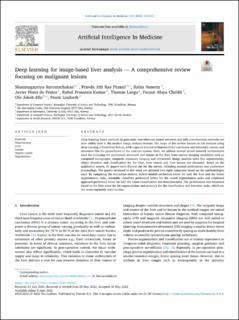| dc.contributor.author | Survarachakan, Shanmugapriya | |
| dc.contributor.author | Prasad, Pravda Jith Ray | |
| dc.contributor.author | Naseem, Rabia | |
| dc.contributor.author | Perez de Frutos, Javier | |
| dc.contributor.author | Kumar, Rahul Prasanna | |
| dc.contributor.author | Langø, Thomas | |
| dc.contributor.author | Alaya Cheikh, Faouzi | |
| dc.contributor.author | Elle, Ole Jakob | |
| dc.contributor.author | Lindseth, Frank | |
| dc.date.accessioned | 2023-03-14T13:31:05Z | |
| dc.date.available | 2023-03-14T13:31:05Z | |
| dc.date.created | 2022-09-15T11:59:04Z | |
| dc.date.issued | 2022 | |
| dc.identifier.citation | Artificial Intelligence in Medicine. 2022, 130 1-23. | en_US |
| dc.identifier.issn | 0933-3657 | |
| dc.identifier.uri | https://hdl.handle.net/11250/3058202 | |
| dc.description.abstract | Deep learning-based methods, in particular, convolutional neural networks and fully convolutional networks are now widely used in the medical image analysis domain. The scope of this review focuses on the analysis using deep learning of focal liver lesions, with a special interest in hepatocellular carcinoma and metastatic cancer; and structures like the parenchyma or the vascular system. Here, we address several neural network architectures used for analyzing the anatomical structures and lesions in the liver from various imaging modalities such as computed tomography, magnetic resonance imaging and ultrasound. Image analysis tasks like segmentation, object detection and classification for the liver, liver vessels and liver lesions are discussed. Based on the qualitative search, 91 papers were filtered out for the survey, including journal publications and conference proceedings. The papers reviewed in this work are grouped into eight categories based on the methodologies used. By comparing the evaluation metrics, hybrid models performed better for both the liver and the lesion segmentation tasks, ensemble classifiers performed better for the vessel segmentation tasks and combined approach performed better for both the lesion classification and detection tasks. The performance was measured based on the Dice score for the segmentation, and accuracy for the classification and detection tasks, which are the most commonly used metrics. | en_US |
| dc.language.iso | eng | en_US |
| dc.publisher | Elsevier | en_US |
| dc.rights | Navngivelse 4.0 Internasjonal | * |
| dc.rights.uri | http://creativecommons.org/licenses/by/4.0/deed.no | * |
| dc.title | Deep learning for image-based liver analysis — A comprehensive review focusing on malignant lesions | en_US |
| dc.title.alternative | Deep learning for image-based liver analysis — A comprehensive review focusing on malignant lesions | en_US |
| dc.type | Peer reviewed | en_US |
| dc.type | Journal article | en_US |
| dc.description.version | publishedVersion | en_US |
| dc.source.pagenumber | 1-23 | en_US |
| dc.source.volume | 130 | en_US |
| dc.source.journal | Artificial Intelligence in Medicine | en_US |
| dc.identifier.doi | 10.1016/j.artmed.2022.102331 | |
| dc.identifier.cristin | 2051984 | |
| dc.relation.project | EC/H2020/722068 | en_US |
| cristin.ispublished | true | |
| cristin.fulltext | original | |
| cristin.qualitycode | 2 | |

